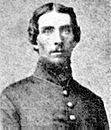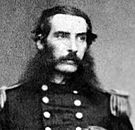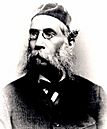Horace Parnell Tuttle facts for kids
Horace Parnell Tuttle (born March 17, 1837 – died August 16, 1923) was an American astronomer. He was also a veteran of the American Civil War. His brother, Charles Wesley Tuttle, was also an astronomer.
Biography
Early Life and Discoveries
Horace Parnell Tuttle was born in Newfield, Maine. His parents were Moses and Mary Tuttle. After his mother passed away, his family moved to Cambridge, Massachusetts.
His older brother, Charles Wesley Tuttle, was also an astronomer. Charles even built his own telescope! He impressed William Cranch Bond at the Harvard Observatory and became an assistant there in 1850. Charles was the first to suggest that Saturn had a faint, inner 'dusky ring'. He discovered a comet in 1853. Sadly, Charles had to stop his astronomy work because his eyesight got bad. He then studied law and became a U.S. Commissioner.
Horace took over from his brother at Harvard. He worked as an assistant with other astronomers like Truman Henry Safford and Asaph Hall. Horace loved using a special four-inch telescope called a 'comet seeker'. He spent many nights looking for new comets.
Horace Tuttle discovered or co-discovered many comets. These include 55P/Tempel-Tuttle, which is the parent body of the Leonid meteor shower. He also found 109P/Swift-Tuttle, which is the parent body of the Perseid meteor shower. Other comets named after him are 8P/Tuttle and 41P/Tuttle-Giacobini-Kresak. The asteroid 5036 Tuttle was named in his honor. In 1859, he won the Lalande Prize from the French Academy of Sciences for finding several comets.
Tuttle is also known for "discovering" two galaxies: NGC 2655 and NGC 6643. He also experimented with Morse code and invented a way to signal long distances using light flashes. He also created a new method for making cannons stronger. His old observing notebooks are kept at the United States Naval Observatory.
War Service
When the American Civil War began, Horace Tuttle joined the 44th Massachusetts Volunteer Infantry. He served in North Carolina. Later, he joined the U.S. Navy as a paymaster. He served on several ships, including the USS Catskill. He helped block Charleston Harbor and capture a blockade runner ship called Deer.
He was appointed assistant paymaster in 1863 and paymaster in 1866. Even during the war, Tuttle continued to observe the sky. He reported seeing Comet Tempel 1864 II from his ship, the Catskill. After the war, Tuttle traveled to South America, Europe, and the Pacific. He made scientific observations on Naval survey ships.
Later Life
After the war, Tuttle returned to his passion for finding comets. He discovered comet 1866 I at the Naval Observatory in 1866. This was Comet Tempel-Tuttle, which another astronomer had seen earlier. This was only the second comet ever found at the Naval Observatory.
In 1871, Tuttle found periodic comet 8/P1871 T1 Tuttle again. In the same year, he worked with Commodore George Dewey to survey the coast of lower California. In 1872, he was assigned to a survey ship in Hong Kong. In 1875, Tuttle and E. S. Holden found periodic comet 2P/Encke again.
Tuttle's brother, Francis, also served in the Navy. He was a captain of a ship called the US Revenue Cutter Bear. In 1897, Francis Tuttle was ordered to rescue 14 whaling ships trapped in ice in Alaska.
In 1875, Horace Tuttle joined a survey team for the Interior Department. He helped map the Black Hills of Dakota and measure heights of mountains. For the next five years, he surveyed borders in Dakota, Wyoming, Colorado, and Utah.
In 1887, Tuttle had a special telescope called a 'comet seeker' made for him. It was placed on the roof of the Naval Observatory. Here, he made his last comet discovery, finding Comet 1888V Barnard again.
Horace Tuttle lived in the Washington, D.C. area until he passed away in 1923. He was almost blind in his final years. His grave is in Oakwood Cemetery, Falls Church, but its exact location is unknown.
| C/1857II Bruhns | April 1857 |
| C/1857 Q1 (Klinkerfues) (1857 V) | August 23, 1857 |
| C/1857 V1 (Donati-van Arsdale) (1857 VI) | November 11, 1857 |
| 8P/Tuttle | January 5, 1858 |
| 41P/Tuttle-Giacobini-Kresak | May 2, 1858 |
| C/1858 R1 (Tuttle) (1858 VII) | September 5, 1858 |
| C/1859 G1 (Tempel) | April 24, 1859 |
| C/1860 M1 (1860 III) | June 22, 1860 |
| C/1861 III | December 18, 1861 |
| 109P/Swift-Tuttle | July 19, 1862 |
| C/1861 Y1 (Tuttle) | December 19, 1862 |
| 55P/Tempel-Tuttle | January 5, 1866 |
| 8P/Tuttle | October 23, 1871 |
| 2P/Encke | January 26, 1875 |
| C/1888 U1 (Barnard) (1888 V) | November 1, 1888 |
| 66 Maja | April 9, 1861 |
| 73 Klytia | April 7, 1862 |
Gallery
See also
 In Spanish: Horace Parnell Tuttle para niños
In Spanish: Horace Parnell Tuttle para niños




